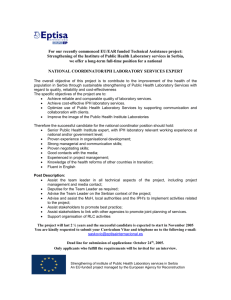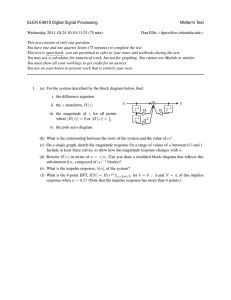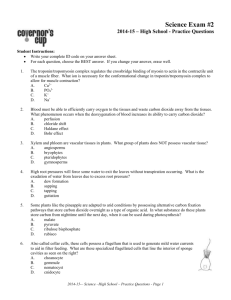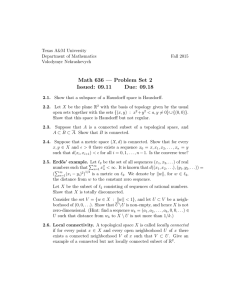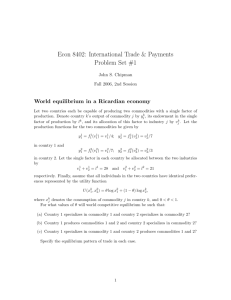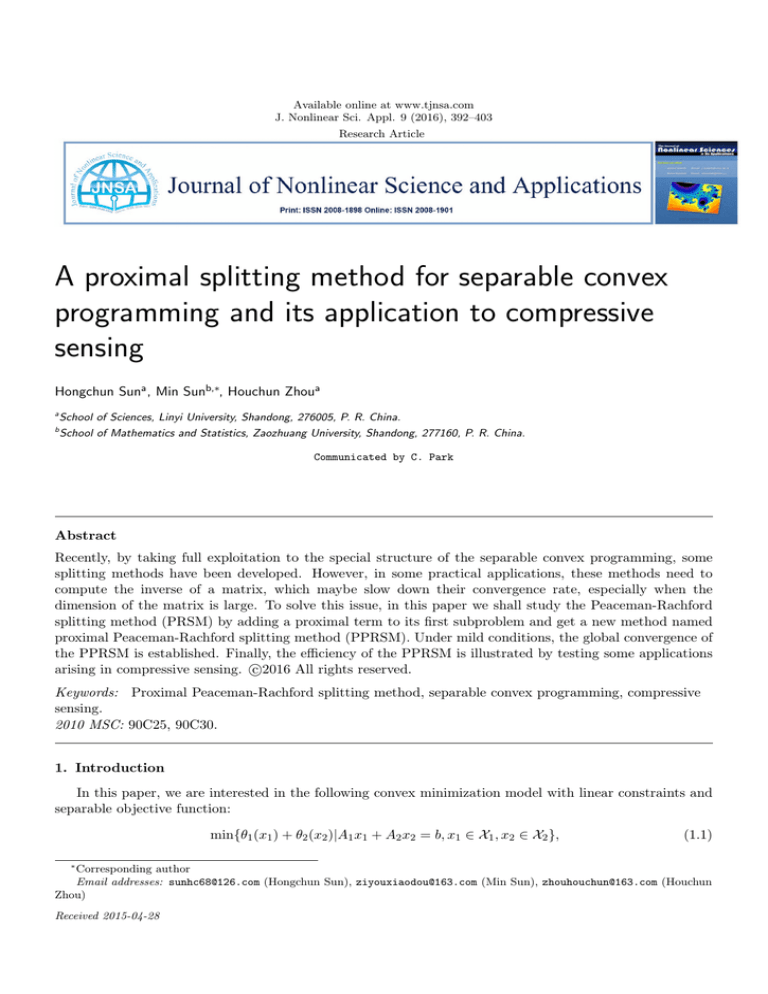
Available online at www.tjnsa.com
J. Nonlinear Sci. Appl. 9 (2016), 392–403
Research Article
A proximal splitting method for separable convex
programming and its application to compressive
sensing
Hongchun Suna , Min Sunb,∗, Houchun Zhoua
a
School of Sciences, Linyi University, Shandong, 276005, P. R. China.
b
School of Mathematics and Statistics, Zaozhuang University, Shandong, 277160, P. R. China.
Communicated by C. Park
Abstract
Recently, by taking full exploitation to the special structure of the separable convex programming, some
splitting methods have been developed. However, in some practical applications, these methods need to
compute the inverse of a matrix, which maybe slow down their convergence rate, especially when the
dimension of the matrix is large. To solve this issue, in this paper we shall study the Peaceman-Rachford
splitting method (PRSM) by adding a proximal term to its first subproblem and get a new method named
proximal Peaceman-Rachford splitting method (PPRSM). Under mild conditions, the global convergence of
the PPRSM is established. Finally, the efficiency of the PPRSM is illustrated by testing some applications
c
arising in compressive sensing. 2016
All rights reserved.
Keywords: Proximal Peaceman-Rachford splitting method, separable convex programming, compressive
sensing.
2010 MSC: 90C25, 90C30.
1. Introduction
In this paper, we are interested in the following convex minimization model with linear constraints and
separable objective function:
min{θ1 (x1 ) + θ2 (x2 )|A1 x1 + A2 x2 = b, x1 ∈ X1 , x2 ∈ X2 },
∗
(1.1)
Corresponding author
Email addresses: sunhc68@126.com (Hongchun Sun), ziyouxiaodou@163.com (Min Sun), zhouhouchun@163.com (Houchun
Zhou)
Received 2015-04-28
H. C. Sun, M. Sun, H. C. Zhou, J. Nonlinear Sci. Appl. 9 (2016), 392–403
393
where Ai ∈ Rl×ni (i = 1, 2), b ∈ Rl and Xi ⊂ Rni (i = 1, 2) are nonempty closed convex sets, θi : Rni →
R(i = 1, 2) are convex but not necessarily smooth functions, such as in compressive sensing, θ1 refers to a
data-fidelity term and θ2 denotes a regularization term. Throughout this paper, we assume that the solution
set of (1.1) is nonempty and Ai (i = 1, 2) are full column-rank matrices.
A fundamental method for solving (1.1) is the Peaceman-Rachford splitting method (PRSM)[6, 7], which
was presented originally in [1]. The standard PRSM iterative scheme is:
k+1
x1 = argminx1 ∈X1 {θ1 (x1 ) − (λk )> (A1 x1 + A2 xk2 − b) + β2 kA1 x1 + A2 xk2 − bk2 },
λk+ 21 = λk − β(A xk+1 + A xk − b),
1 1
2 2
(1.2)
β
k+1
k+1
k+1
k+ 21 >
2 },
)
(A
x
+
A
x
−
b)
+
x
=
argmin
{θ
(x
)
−
(λ
kA
x
+
A
x
−
bk
1
2
2
2
2
1
2
2
x
∈X
2
2
1
2
1
2
1
k+1
+ A2 xk+1
− b).
λ
= λk+ 2 − β(A1 xk+1
1
2
The PRSM has been well studied in the literature[3, 4, 5, 8]. The PRSM scheme is always efficient when it
is convergent. However, according to [1, 4], the sequence generated by PRSM maybe does not satisfy the
strictly contractive property, which results in divergence of the PRSM. To deal with this issue, He et al. [4]
developed a strictly contractive Peaceman-Rachford splitting method (SCPRSM), and its iterative scheme
is:
k+1
x1 = argminx1 ∈X1 {θ1 (x1 ) − (λk )> (A1 x1 + A2 xk2 − b) + β2 kA1 x1 + A2 xk2 − bk2 },
λk+ 21 = λk − αβ(A xk+1 + A xk − b),
2 2
1 1
(1.3)
1
k+1
x
=
argmin
+ A2 x2 − bk2 },
{θ
(x
)
−
(λk+ 2 )> (A1 xk+1
+ A2 x2 − b) + β2 kA1 xk+1
x2 ∈X2 2 2
2
1
1
1
k+1
− b),
+ A2 xk+1
λ
= λk+ 2 − αβ(A1 xk+1
2
1
where the parameter α ∈ (0, 1). Obviously, the iterative scheme (1.3) reduces to the (1.2) if α = 1. However,
to ensure the global convergence of (1.3), the parameter α must be restricted in the interval (0, 1). The most
important property of the SCPRSM is that its generated sequence satisfies the strictly contractive property.
However, similar to other splitting methods, the SCPRSM also has to compute the inverse of a matrix
in some practical applications, such as the numerical examples in [4]: the statistical learning problems and
the image reconstruction models (see iterative schemes (6.5)-(6.11) or (6.20)-(6.21) in [4]). In fact, we need
to compute the matrix (D> D + βI)−1 , where D ∈ Rn×d is the design matrix and I is the identity matrix,
which is quite time consuming if the dimension d is large. In order to solve this issue, in this paper, we
propose a proximal Peaceman-Rachford splitting method (PPRSM), which regularizes the first subproblem
in (1.3) by the proximal regularization 12 kA1 (x1 − xk1 )k2R , where R ∈ Rl×l is a positive definite matrix. The
relationship between SCPRSM and PPRSM can be summarized as follows: in fact, the matrix (D> D+βI)−1
in SCPRSM is resulted from the quadratic term in the objective function. Similar to [2], we can linearize
the quadratic term and add a proximal term, and get an implementable iterative scheme, which is just
SCPRSM with a special matrix R.
The rest of this paper is organized as follows. In Section 2, we describe the proximal Peaceman-Rachford
splitting method and prove its global convergence in detail. The application of the PPRSM to compressive
sensing are discussed in Section 3. In Section 4, we compare our algorithm with SCPRSM to illustrate the
efficiency by performing numerical experiments. Finally, some conclusions are drawn in Section 5.
To end this section, some notations used in this paper are list. We use Rn+ to denote the nonnegative
quadrant in Rn ; the vector x+ denotes the orthogonal projection of vector x ∈ Rn onto Rn+ , that is,
(x+ )i := max{xi , 0}, 1 ≤ i ≤ n; the norm k · k1 , k · k and k · kM denote the Euclidean 1-norm, 2-norm and
M -norm, respectively. For x, y ∈ Rn , we use (x; y) to denote the column vector (x> , y > )> , and use Im to
denote an identity matrix of order m. The transpose of a matrix M is denoted by M > .
2. Algorithm and Global Convergence
In this section, we first develop an equivalent reformulation of the problem (1.1) by a mixed variational
inequality problem (denoted by VI(W, F, θ)). Then we describe a proximal Peaceman-Rachford splitting
method (PPRSM) for the VI(W, F, θ), and establish its global convergence.
H. C. Sun, M. Sun, H. C. Zhou, J. Nonlinear Sci. Appl. 9 (2016), 392–403
394
First, we define some auxiliary variables: x = (x1 , x2 ), w = (x, λ) and θ(x) = θ1 (x1 ) + θ2 (x2 ). Then, by
invoking the first-order optimality condition for convex programming, we can reformulate problem (1.1) as
the following variational inequality problem (denoted by VI(W, F, θ)): Finding a vector w∗ ∈ W such that
θ(x) − θ(x∗ ) + (w − w∗ )> F (w∗ ) ≥ 0, ∀w ∈ W,
where W = X1 × X2 × Rl , w = (x, λ) = (x1 , x2 , λ) and
−A>
1λ
= M̄ w + p̄,
−A>
F (w) =
2λ
A1 x 1 + A2 x 2 − b
where
(2.1)
(2.2)
0
0 −A>
0
1
0 .
0 −A>
M̄ = 0
,
p̄
=
2
b
A1 A2
0
We denote the set of (2.1) by W ∗ . Then, W ∗ is nonempty under nonempty assumption onto the solution
set of problem (1.1).
In this following, a proximal Peaceman-Rachford splitting method (PPRSM) for solving the VI(W, F, θ)
is outlined.
Algorithm 2.1. PPRSM
Step 0. Choose the parameters α ∈ (0, 1), β > 0, a positive definite matrix R ∈ Rl×l , the tolerance
ε > 0 and the initial iterate w0 = (x01 , x02 , λ0 ) ∈ X1 × X2 × Rl . Set k := 0.
k+1 k+1
) by solving the following problem
Step 1. The new iterate wk+1 = (xk+1
1 , x2 , λ
k+1
β
1
k >
k
2
k 2
x1 1 = argminx1 ∈X1 {θ1 (x1 ) − (λ ) A1 x1 + 2 kA1 x1 + A2 x2 − bk + 2 kA1 (x1 − x1 )kR },
λk+ 2 = λk − αβ(A xk+1 + A xk − b),
2 2
1 1
(2.3)
β
k+1
k+1
k+ 21 >
2 },
=
argmin
x
{θ
(x
)
−
(λ
)
A
x
+
+
A
x
−
bk
kA
x
2
2
2
2
2
2
1
x
∈X
2
2
2
1
2
1
k+1
+ A2 xk+1
− b).
λ
= λk+ 2 − αβ(A1 xk+1
1
2
Step 2. If
k+1
k
k+1
k
k} < ,
max{kA1 (xk1 − xk+1
1 )k, kA2 (x2 − x2 )k, kλ − λ
(2.4)
k+1 k+1
)
(xk+1
1 , x2 , λ
is a solution of VI(W, F, θ); otherwise, set k := k + 1, go to Step 1.
stop, then
For the ease of description,we denote the sequence {ŵk } as
x̂k1
xk+1
1
.
ŵk = x̂k2 =
xk+1
2
k+1
k
k
k
λ̂
λ − β(A1 x1 + A2 x2 − b)
(2.5)
By the second equality of (2.3), one has
1
λk+ 2 = λk − α[λk − (λk − β(A1 xk+1
+ A2 xk2 − b))] = λk − α(λk − λ̂k ).
1
(2.6)
Combining this with the fourth equality of (2.3), one has
1
λk+1 = λk+ 2 − αβ[(A1 xk+1
+ A2 xk2 − b) − (A2 xk2 − A2 xk+1
1
2 )]
1
k+1
k+1
k+ 2
k
k
=λ
− αβ(A1 x1 + A2 x2 − b) + αβA2 (x2 − x2 )
k+ 21
=λ
− α[λk − (λk − β(A1 xk+1
+ A2 xk2 − b))] + αβA2 (xk2 − xk+1
1
2 )
1
k+1
k+ 2
k
k
k
=λ
− α(λ − λ̂ ) + αβA2 (x2 − x2 )
k
= λ − [2α(λk − λ̂k ) − αβA2 (xk2 − x̂k2 )].
(2.7)
H. C. Sun, M. Sun, H. C. Zhou, J. Nonlinear Sci. Appl. 9 (2016), 392–403
Combining this with (2.5), we obtian
k
x1
wk+1 = xk2
λk
k
x1
xk2
=
λk
xk1 − xk+1
1
− xk − xk+1
2
2
λk − λk+1
xk1 − x̂k1
−
xk2 − x̂k2
k
k
k
k
−αβA2 (x2 − x̂2 ) + 2α(λ − λ̂ )
395
(2.8)
= wk − M (wk − ŵk ),
where
In1
M = 0
0
0
0
0 .
In2
−αβA2 2αIl
(2.9)
Based on above analysis, we would show that the algorithm is globally convergent. To this end, we first
give the following needed lemma.
k+1 k+1
Lemma 2.1. If Ai xki = Ai xk+1
(i = 1, 2) and λk = λk+1 , then wk+1 = (xk+1
) produced by
1 , x2 , λ
i
PPRSM is a solution of VI(W, F, θ).
Proof. By deriving the first-order optimality condition of x1 -subproblem in (2.3), for any x1 ∈ X1 , we have
>
k+1 >
(2.10)
θ1 (x1 ) − θ1 (xk+1
− xk1 )] ≥ 0.
+ A2 xk2 − b) + RA1 (xk+1
A1 [−λk + β(A1 xk+1
1 ) + (x1 − x1 )
1
1
From the definition of λ̂k in (2.5), (2.10) can be written as
k+1 >
k+1
k
>
θ1 (x1 ) − θ1 (xk+1
− xk1 ) ≥ 0, ∀x1 ∈ X1 .
−A>
1 ) + (x1 − x1 )
1 λ̂ + A1 RA1 (x1
(2.11)
Similarly, from the x2 -subproblem in (2.3), we have
o
n
k+1 >
k+1
k+1
> k+ 12
>
≥ 0, ∀x2 ∈ X2 .
)
)
+
(x
−
x
θ2 (x2 ) − θ2 (xk+1
−
b)
−A
λ
+
A
x
+
βA
(A
x
2
2
1
2
2
2
2
2
1
(2.12)
1
By the definition of λk+ 2 in (2.3) and λ̂k in (2.5), one has
1
k+1
k+ 2
− A>
+ βA>
+ A2 xk+1
− b)
2λ
2 (A1 x1
2
k+1
k
− b)]
+ A2 xk+1
= A>
+ A2 xk2 − b) + β(A1 xk+1
2 [−λ + αβ(A1 x1
2
1
k+1
k
= A>
+ A2 xk2 − b) + αβ(A1 xk+1
+ A2 xk2 − b) − β(A1 xk+1
+ A2 xk2 − b)
2 [−λ + β(A1 x1
1
1
(2.13)
+ β(A1 xk+1
+ A2 xk2 − b) + β(A2 xk+1
− A2 xk2 )]
1
2
k+1
k
>
k
k
= −A>
− xk2 ) − αA>
2 λ̂ + βA2 A2 (x2
2 (λ̂ − λ )].
Combining (2.12) with (2.13), one has
k+1 >
k+1
k
>
k
k
θ2 (x2 ) − θ2 (xk+1
−A>
− xk2 ) − αA>
2 ) + (x2 − x2 )
2 λ̂ + βA2 A2 (x2
2 (λ̂ − λ )] ≥ 0, ∀x2 ∈ X2 . (2.14)
In addition, from (2.5) again, we have
(A1 xk+1
+ A2 xk+1
− b) − A2 (xk+1
− xk2 ) +
1
2
2
1 k
(λ̂ − λk ) = 0.
β
(2.15)
Using (2.11), (2.14), (2.15) and xk+1
= x̂ki (i = 1, 2), for any w = (x1 , x2 , λ) ∈ W, it holds that
i
k
k
k
A>
−A>
1 RA1 (x̂1 − x1 )
1 λ̂
k
k >
>
k
k
>
k
k
>
k
βA
A
(x̂
−
x
)
−
αA
(
λ̂
−
λ
)
θ(x) − θ(x̂ ) + (w − ŵ )
+
≥ 0.
−A2 λ̂
2 2 2
2
2
A1 x̂k1 + A2 x̂k2 − b
−A2 (x̂k2 − xk2 ) + (λ̂k − λk )/β
H. C. Sun, M. Sun, H. C. Zhou, J. Nonlinear Sci. Appl. 9 (2016), 392–403
396
For any w ∈ W, the above inequality can be written as
where
θ(x) − θ(x̂k ) + (w − ŵk )> F (ŵk ) ≥ (w − ŵk )> Q(wk − ŵk ),
(2.16)
A>
0
0
1 RA1
>
0
βA>
Q=
.
2 A2 −αA2
1
0
−A2
I
β l
(2.17)
If Ai xki = Ai xk+1
(i = 1, 2) and λk = λk+1 , combining (2.5) with (2.7), we have Ai xki = Ai x̂ki (i = 1, 2) and
i
λk = λ̂k . Thus,
Q(wk − ŵk ) = 0.
(2.18)
Combining this with (2.16), one has
θ(x) − θ(x̂k ) + (w − ŵk )> F (ŵk ) ≥ 0, ∀w ∈ W,
which implies that ŵk = (x̂k1 , x̂k2 , λ̂k ) is a solution of VI(W, F, θ). Since ŵk = wk+1 , so wk+1 is a solution of
VI(W, F, θ).
Lemma 2.2. The matrices M, Q defined in (2.9) and (2.17), respectively. Then, we have
HM = Q,
and the matrix H is positive definite, where
>
A1 RA1
0
H=
0
(2.19)
0
0
2−α
1 >
>
.
2 βA2 A2 − 2 A2
1
1
− 2 A2
I
2αβ l
Proof. Using (2.9) and (2.17), one has
>
A1 RA1
0
0
In2
1 >
2−α
>
0
0
HM =
2 βA2 A2 − 2 A2
1
0
− 21 A2
I
0
l
2αβ
>
A1 RA1
0
0
>
0
βA>
= Q.
=
2 A2 −αA2
1
I
0
−A2
β l
(2.20)
0
0
In2
0
−αβA2 2αIl
Then the first assertion is proved.
Since R is a positive definite matrix, there exists positive definite matrix R1 ∈ Rl×l , such that R = R1> R1 .
By a simple manipulation, we obtain
> >
A1 R1 √ 0
0
R 1 A1 √ 0
0
Il
0
0
1
0
βA2
0 .
0
βA>
0 0 2−α
H=
2
2 Il
2 Il
1
1
1
1
√ Il
√ Il
0
0
0
0
0
β
β
2 Il
2α Il
Since the matrix
Il
0
0
0
2−α
2 Il
1
2 Il
0
1
2 Il
1
2α Il
is positive definite if α ∈ (0, 1), and Ai (i = 1, 2) are full column-rank matrices. Thus, H is positive definite
if α ∈ (0, 1).
H. C. Sun, M. Sun, H. C. Zhou, J. Nonlinear Sci. Appl. 9 (2016), 392–403
397
Lemma 2.3. Let the sequence {wk } be generated by PPRSM. Then, for any w ∈ W, one has
1
1
(w − ŵk )> Q(wk − ŵk ) ≥ (kw − wk+1 k2H − kw − wk k2H ) + kwk − ŵk k2N ,
2
2
(2.21)
where the matrices Q, H defined in (2.17) and (2.20), respectively, and
>
A1 RA1
0
0
β(1−α) >
0
A2 A2
0
N =
.
4
2(1−α)
0
0
3β Il
Proof. From the fact that
1
1
(a − b)> H(c − d) = (ka − dk2H − ka − ck2H ) + (kc − bk2H − kd − bk2H ), ∀a, b, c, d ∈ Rn .
2
2
Setting a = w, b = ŵk , c = wk , d = wk+1 , one has
1
1
(w − ŵk )> H(wk − wk+1 ) = (kw − wk+1 k2H − kw − wk k2H ) + (kwk − ŵk k2H − kwk+1 − ŵk k2H ).
2
2
Using the above equality, combining (2.19) with (2.8), we obtain
(w − ŵk )> Q(wk − ŵk ) = (w − ŵk )> HM (wk − ŵk )
= (w − ŵk )> H(wk − wk+1 )
1
1
= (kw − wk+1 k2H − kw − wk k2H ) + (kwk − ŵk k2H − kwk+1 − ŵk k2H ).
2
2
(2.22)
For the last term of (2.22), using (2.8), one has
kwk − ŵk k2H − kwk+1 − ŵk k2H
= kwk − ŵk k2H − k(wk − ŵk ) − (wk − wk+1 )k2H
= kwk − ŵk k2H − k(wk − ŵk ) − M (wk − ŵk )k2H
= 2(wk − ŵk )> HM (wk − ŵk ) − (wk − ŵk )> M > HM (wk − ŵk )
= (wk − ŵk )> (Q> + Q − M > HM )(wk − ŵk ).
Using (2.9),(2.17) and (2.19), a direct computation yields that
A>
0
0
1 RA1
>
0
(1 − α)βA>
Q> + Q − M > HM = Q> + Q − M > Q =
2 A2 −(1 − α)A2 .
2(1−α)
Il
0
−(1 − α)A2
β
Combining this with (2.23), using the Cauchy-Schwartz Inequality, one has
(wk − ŵk )> (Q> + Q − M > HM )(wk − ŵk )
= kA1 (xk1 − x̂k1 )k2R + (1 − α){βkA2 (xk2 − x̂k2 )k2 − 2[A2 (xk2 − x̂k2 )]> (λk − λ̂k )
2
+ kλk − λ̂k k2 }
β
β
2
= kA1 (xk1 − x̂k1 )k2R + (1 − α){ kA2 (xk2 − x̂k2 )k2 +
kλk − λ̂k k2
4
3β
3β
4
+ kA2 (xk2 − x̂k2 )k2 − 2[A2 (xk2 − x̂k2 )]> (λk − λ̂k ) +
kλk − λ̂k k2 }
4
3β
2
β
kλk − λ̂k k2 }
≥ kA1 (xk1 − x̂k1 )k2R + (1 − α){ kA2 (xk2 − x̂k2 )k2 +
4
3β
= kwk − ŵk k2N .
(2.23)
H. C. Sun, M. Sun, H. C. Zhou, J. Nonlinear Sci. Appl. 9 (2016), 392–403
398
Combining this with (2.23), one has
kwk − ŵk k2H − kwk+1 − ŵk k2H ≥ kwk − ŵk k2N .
Combining this with (2.22), we have that (2.21) holds.
Theorem 2.4. Let {wk } be the sequence generated by PPRSM. Then, for any w ∈ W, we have
1
1
θ(x) − θ(x̂k ) + (w − ŵk )> F (w) ≥ (kw − wk+1 k2H − kw − wk k2H ) + kwk − ŵk k2N .
2
2
(2.24)
Proof. From (2.2), a direct computation yields that
(w − ŵk )> (F (w) − F (ŵk )) = 0.
Thus, one has (w − ŵk )> F (w) = (w − ŵk )> F (ŵk ). Combining this, using (2.16) and (2.21), we obtain that
(2.24) holds.
Using the above theorem, we first prove that the stopping criterion (2.4) is reasonable.
Theorem 2.5. Let {wk } be the sequence generated by PPRSM. Then, we have
lim kA1 (xk1 − x̂k1 )k = 0, lim kA2 (xk2 − x̂k2 )k = 0, and
k→∞
k→∞
lim kλk − λ̂k k = 0.
k→∞
(2.25)
Proof. Setting w = w∗ ∈ W ∗ in (2.24), we obtain
kwk − w∗ k2H − kwk − ŵk k2N ≥ 2{θ(x̂k ) − θ(x∗ ) + (ŵk − w∗ )> F (w∗ )} + kwk+1 − w∗ k2H
≥ kwk+1 − w∗ k2H ,
where the second inequality follows from w∗ ∈ W ∗ . Thus, one has
kwk+1 − w∗ k2H ≤ kwk − w∗ k2H − kwk − ŵk k2N .
(2.26)
Using (2.26), a direct computation yields that
∞
X
kwk − ŵk k2N ≤ kw0 − w∗ k2H ,
k=0
which implies that
lim kwk − ŵk kN = 0.
k→∞
(2.27)
Combining (2.27) with the matrix N defined in Lemma 2.3, we have that (2.25) holds.
Now, we are ready to establish the global convergence of PPRSM for solving VI(W, F, θ).
Theorem 2.6. Let {wk } be the sequence generated by PPRSM. Then, the sequence {wk } converges to some
w̄ ∈ W ∗ .
Proof. From (2.26), we have
kwk+1 − w∗ k2H ≤ kwk − w∗ k2H .
Using (2.28), a direct computation yields that
kwk+1 − w∗ k2H ≤ kw0 − w∗ k2H ,
(2.28)
H. C. Sun, M. Sun, H. C. Zhou, J. Nonlinear Sci. Appl. 9 (2016), 392–403
399
which indicates that the sequence {wk } is bounded. Combining this with (2.27), the sequence {ŵk } is also
bounded. Therefore, it has at least one cluster point. Let w̄ be a cluster point of {ŵk } and the subsequence
{ŵkj } converges to w̄.
On the other hand, combining (2.25) with the definition of Q in (2.17), we have
lim Q(wk − ŵk ) = 0.
k→∞
Combining this with (2.16), we get
lim {θ(x) − θ(x̂k ) + (w − ŵk )> F (ŵk )} ≥ 0, ∀w ∈ W.
k→∞
(2.29)
Substituting x̂k in (2.29) with ŵkj , and letting kj → ∞, we have
θ(x) − θ(x̄) + (w − w̄)> F (w̄) ≥ 0, ∀w ∈ W,
which implies that w̄ ∈ W ∗ .
From limk→∞ kwk − ŵk kN = 0, we can deduce limk→∞ kwk − ŵk kH = 0, combining this with {ŵkj } → w̄,
for any given > 0, there exists an integer l such that
kwkl − ŵkl kH < , and kŵkl − w̄kH < .
2
2
Thus, for any k ≥ kl , using the above two equalities and (2.28) that
kwk − w∞ kH ≤ kwkl − w̄kH ≤ kwkl − ŵkl kH + kŵkl − w̄kH < .
Thus, the sequence {wk } converges to w̄ ∈ W ∗ .
3. Application to Compressive Sensing
Compressive sensing (CS) is to recover a sparse signal x̄ ∈ Rn from an undetermined linear system
y = Ax̄, where A ∈ Rm×n (m n) is the sensing matrix, and a fundamental decoding model in CS is the
so-called unconstrained basis pursuit denoising (QPρ ) problem, which can be depicted as
1
minn f (x) = kAx − yk22 + ρkxk1 ,
x∈R
2
(3.1)
where ρP > 0 is the regularization parameter and kxk1 is the l1 -norm of the vector x defined as
kxk1 = ni=1 |xi |.
Now, by introducing auxiliary variables µi and νi , i = 1, 2, · · · , n, and letting
µi + νi = |xi |, µi − νi = xi , i = 1, 2, · · · , n.
Thus, the problem QPρ is written as
min
(µ;ν)∈R2n
1
k(A, −A)(µ; ν) − yk22 + ρ(e> , e> )(µ; ν),
2
(3.2)
s.t. (µ; ν) ≥ 0,
where e ∈ Rn denote the vector composed by elements 1.
Now, we can transform the problem (3.2) into the following problem. Letting x1 = (µ; ν), x2 = (µ; ν),
one has
1
k(A, −A)x1 − yk22 + ρ(e> , e> )x2 ,
2
s.t. x1 − x2 = 0, x1 ≥ 0, x2 ≥ 0,
min
(3.3)
H. C. Sun, M. Sun, H. C. Zhou, J. Nonlinear Sci. Appl. 9 (2016), 392–403
400
which is a special case of (1.1) with
1
θ1 (x1 ) = k(A, −A)x1 − yk22 , θ2 (x2 ) = ρ(e> , e> )x2 , A1 = In , A2 = −In , b = 0, X1 = X2 = R2n
+ .
2
Combining PPRSM with (3.3), we first consider the following problem
1
β
k(A, −A)x1 − yk22 − (λk )> x1 + kx1 − xk2 k22 ,
2
2
2n
s.t. x1 ∈ R+ .
min
(3.4)
By a direct computation, we can establish the following equivalent formulation of (3.4)
1
kx1 − ([(A, −A)> (A, −A) + βI2n ]−1 [(A, −A)> y + λk + βxk2 ])k2M̂ ,
2
s.t. x1 ∈ R2n
+ ,
min
(3.5)
where M̂ = (A, −A)> (A, −A) + βI2n . Thus, the solution of (3.5) is given by
xk+1
= ([(A, −A)> (A, −A) + βI2n ]−1 [(A, −A)> y + λk + βxk2 ])+ .
1
However, the computation of [(A, −A)> (A, −A) + βI2n ]−1 is very time consuming if n is large. Then, we
linearize 12 k(A, −A)x1 − yk22 at the current point xk1 and add a proximal term, i.e.,
1
1
1
k(A, −A)x1 − yk22 ≈ k(A, −A)xk1 − yk22 + (g k )> (x1 − xk1 ) + kx1 − xk1 k2 ,
2
2
2τ
where g k = (A, −A)> ((A, −A)xk1 − y) denotes the gradient at xk1 , and τ > 0 is a parameter. Thus, (3.4) is
approximated by the following problem
1
1
β
k(A, −A)xk1 − yk22 + (g k )> (x1 − xk1 ) + kx1 − xk1 k2 − (λk )> x1 + kx1 − xk2 k2
2
2τ
2
s.t. x1 ∈ R2n
,
+
min
which can be written as
min (g k )> x1 +
1
β
kx1 − xk1 k2 − (λk )> x1 + kx1 − xk2 k2
2τ
2
(3.6)
s.t. x1 ∈ R2n
+ .
Obviously, the above problem has the solution
xk+1
=
1
1
τ
(λk + xk1 + βxk2 − g k )+ .
1 + βτ
τ
In the following, we show that (3.6) is the x1 -subproblem of (2.3) with R = τ1 I2n − (A, −A)> (A, −A). In
fact, setting R = τ1 I2n − (A, −A)> (A, −A) in (2.3), we have
1
β
1
argminx1 ∈R2n
{ k(A, −A)x1 − yk22 − (λk )> x1 + kx1 − xk2 k2 + kx1 − xk1 k2R }
+
2
2 2 1
2 − (λk )> x + β kx − xk k2
k(A,
−A)x
−
yk
1
1
1
2
2
2
2
= argminx1 ∈R2n
+
+ 12 (x1 − xk1 )> ( τ1 In − (A, −A)> (A, −A))(x1 − xk1 )
1
k(A, −A)x1 − yk22 − (λk )> x1 + β2 kx1 − xk2 k2
2
= argminx1 ∈R2n
1
+
+ 2τ
kx1 − xk1 k2 − 21 k(A, −A)x1 − (A, −A)xk1 k2
β
1
k >
>
>
k
k 2
= argminx1 ∈R2n
{(x
)
(A,
−A)
((A,
−A)x
−
y)
−
(λ
)
x
+
kx
−
x
k
+
kx1 − xk1 k2 }.
1
1
1
1
2
+
2
2τ
H. C. Sun, M. Sun, H. C. Zhou, J. Nonlinear Sci. Appl. 9 (2016), 392–403
401
In addition, if 0 < τ < 1/λmax ((A, −A)> (A, −A)), then R is a positive definite matrix.
Using the newly generated xk+1
1 , the Lagrange multiplier λ is updated via
1
λk+ 2 = λk − αβ(xk+1
− xk2 ).
1
(3.7)
1
k+ 2
Using the updated xk+1
, the x2 -subproblem in (2.3) is given
1 , λ
1
xk+1
= argminx2 ∈R2n
{ρ(e> , e> )x2 + (λk+ 2 )> x2 +
2
+
β
2
kx2 − xk+1
1 k }
2
1 k+ 1
ρ
β
k+1
2 −
= argminx2 ∈R2n
kx
−
(x
−
λ
(e; e))k2 }
{
2
1
+
2
β
β
and its solution is given by
1
ρ
1
xk+1
= (xk+1
− λk+ 2 − (e; e))+ .
2
1
β
β
(3.8)
1
k+ 2
Using the newly generated xk+1
and xk+1
1 , λ
2 , the Lagrange multiplier λ is second updated via
1
λk+1 = λk+ 2 − αβ(xk+1
− xk+1
1
2 ).
(3.9)
4. Numerical Experiments
In this section, we conduct some numerical experiments about compressive sensing to verify the efficiency
of the proposed PPRSM, and compared it with the strictly contractive Peaceman-Rachford splitting method
(SCPRSM) in [4]. All the code were written by Matlab 7.0 and were performed on a ThinkPad computer
equipped with Windows XP, 997MHz and 4.00 GB of memory.
For two methods, the stop criterion is
kfk − fk−1 k
< 10−5 ,
kfk−1 k
where fk denotes the function value at iteration xk . All the initial points are set as [A> y; 0n×1 ].
Firstly, we use PPRSM and SCPRSM to recover a simulated sparse signal from the observation data
corrupted by additive Gaussian white noise, where n = 1000, m = floor(γ ×n), k = floor(σ ×m). Therefore k
is the number of random nonzero elements contained in the original signal. In addition, we set γ = 0.3, σ =
0.2, y = Ax + sw , where sw is the additive Gaussian white noise of zero mean and standard derivation 0.01,
β = mean(|y|), τ = 1.1, ρ = 0.01, and A is generated by:
B = randn(m, n), [Q, R] = qr(B > , 0), A = Q> .
Define
kx̃ − x̄k
,
kx̄k
where x̃ denotes the reconstructive signal. The original signal, the measurement and the reconstructed
signal by SCPRSM and PPRSM are given in Figure 1. Compared the first and the last two subplots in
Figure 1, we clearly see that the original signal is recovered almost exactly by the test two methods. In
addition, the RelErr of SCPRSM is a little smaller than that of our proposed method. In the following,
we shall compare the two methods with respect to the computing time, the number of iterations and the
RelErr. The parameters are set just same as the above discussion except γ and σ, and for SCPRSM, we
use the same parameters as PPRSM. The codes of the two methods are repeatedly run 20 times, and the
average numerical results are listed in Table 1.
RelErr =
From Table 1, we conclude that both methods are efficient in reconstructing the given sparse signals,
and they attained the solutions successfully with comparable RelErr. However, the computing time of the
PPRSM is a little less than that of the SCPRSM. Thus, we conclude that the PPRSM provides a valid
approach for solving CS, and it is competitive with the SCPRSM.
H. C. Sun, M. Sun, H. C. Zhou, J. Nonlinear Sci. Appl. 9 (2016), 392–403
402
Original signal
2
0
−2
100
200
300
400
500
600
Noisy measurement
700
800
900
1000
0.5
0
−0.5
50
100
150
200
SCPRSM (RelErr = 3.35 %)
250
300
2
0
−2
100
200
300
100
200
300
400
500
600
PPRSM (RelErr = 3.55 %)
700
800
900
1000
700
800
900
1000
2
0
−2
400
500
600
Figure 1: The original signal, noisy measurement and reconstruction results
γ
0.3
0.2
0.2
Average
σ
0.2
0.2
0.1
PPRSM
Time
1.0772
1.0608
0.4017
0.8466
Iter
255.8500
370.8500
145.8500
257.5167
RelErr
0.0492
0.0837
0.0562
0.0630
SCPRSM
Time
1.0475
1.0624
1.0585
1.0561
Iter
50.0000
61.6500
60.5500
57.4000
RelErr
0.0452
0.0752
0.0571
0.0592
Table 1: Comparison of PPRSM with SCPRSM
5. Conclusions
In this paper, we developed a new proximal Peaceman-Rachford splitting method (PPRSM), which does
not need to compute the inverse of large matrix. Under mild conditions, we proved its global convergence.
Numerical results of compressive sensing indicate that the new method is efficient for the compressive sensing.
Acknowledgements:
The first author was supported by the Natural Science Foundation of China (Nos. 11171180, 11101303,
and 11271226), the Specialized Research Fund for the Doctoral Program of Chinese Higher Education
(20113705110002), Shandong Province Science and Technology Development Projects (2013GGA13034),
the Domestic Visiting Scholar Project for the Outstanding Young Teacher of Shandong Provincial Universities(2013,2014), and the Applied Mathematics Enhancement Program of Linyi University. The second
author was supported by the foundation of Scientific Research Project of Shandong Universities (J15LI11),
and the Foundation of Zaozhuang University Grants (2014YB03).
H. C. Sun, M. Sun, H. C. Zhou, J. Nonlinear Sci. Appl. 9 (2016), 392–403
403
References
[1] D. P. Bertsekas, Constrained Optimization and Lagrange Multiplier Methods, Academic Press, New York-London,
(1982). 1, 1
[2] S. Cao, Y. Xiao, H. Zhu, Linearized alternating directions method for l1 -norm inequality constrained l1 -norm
minimization, Appl. Numer. Math., 85 (2014), 142–153. 1
[3] D. R. Han, X. M. Yuan, Convergence analysis of the Peaceman-Rachford splitting method for nonsmooth convex
optimization, J. Optim. Theory Appl., (Under-revision). 1
[4] B. He, H. Liu, Z. Wang, X. Yuan, A strictly contractive Peaceman-Rachford splitting method for convex programming, SIAM J. Optim., 24 (2014), 1011–1040. 1, 1, 4
[5] M. Li, X. Yuan, A strictly contractive Peaceman-Rachford splitting method with logarithmic-quadratic proximal
regularization for convex programming, Math. Oper. Res., 2015 (2015). 1
[6] P. L. Lions, B. Mercier, Splitting algorithms for the sum of two nonlinear operators, SIAM J. Num. Anal., 16
(1979), 964–979. 1
[7] D. H. Peaceman, H. H. Rachford, The numerical solution of parabolic elliptic differential equations, SIAM J.
Appl. Math., 3 (1955), 28–41. 1
[8] M. Sun, J. Liu, A proximal Peaceman-Rachford splitting method for compressive sensing, J. Appl. Math. Comput.,
(2015), 1–15. 1

